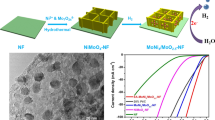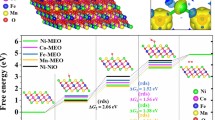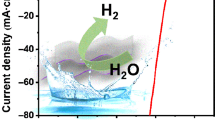Abstract
In most cases, layered transition metal dichalcogenides (LTMDs), containing metallic phases, show electrochemical behavior different from their semiconductor counterparts. Typically, two-dimensional layered metallic 1T-MoS2 demonstrates better electrocatalytic performance for water splitting compared to its 2H counterpart. However, the characteristics of low metallic phase concentration and poor stability limit its applications in some cases. Herein, we demonstrate a simple and efficient bottom-up wet-chemistry strategy for the large-scale synthesis of nanoscopic ultrathin Mo1–xWxS2 nanosheets with enlarged interlayer spacing and high metallic phase concentration. Our characterizations, including X-ray absorption fine structure spectroscopy (XAFS), high-angle annular dark-fieldscanning transmission electron microscopy (HAADF-STEM), and X-ray photoelectron spectroscopy (XPS) revealed that the metallic ultrathin ternary Mo1–xWxS2 nanosheets exhibited distorted metal–metal bonds and a tunable metallic phase concentration. As a proof of concept, this optimized catalyst, with the highest metallic phase concentration (greater than 90%), achieved a low overpotential of about–155 mV at a current density of –10 mA/cm2, a small Tafel slope of 67 mV/dec, and an increased turnover frequency (TOF) of 1.3 H2 per second at an overpotential of –300 mV (vs. reversible hydrogen electrode (RHE)), highlighting the importance of the metallic phase. More importantly, this study can lead to a facile solvothermal route to prepare stable and high-metallicphase-concentration transition-metal-based two-dimensional materials for future applications.

Similar content being viewed by others
References
Karunadasa, H. I.; Chang, C. J.; Long, J. R. A molecular molybdenum-oxo catalyst for generating hydrogen from water. Nature 2010, 464, 1329–1333.
Walter, M. G.; Warren, E. L.; McKone, J. R.; Boettcher, S. W.; Mi, Q. X.; Santori, E. A.; Lewis, N. S. Solar water splitting cells. Chem. Rev. 2010, 110, 6446–6471.
Dresselhaus, M. S.; Thomas, I. L. Alternative energy technologies. Nature 2001, 414, 332–337.
Turner, J. A. Sustainable hydrogen production. Science 2004, 305, 972–974.
Zhao, Y.; Kamiya, K.; Hashimoto, K.; Nakanishi, S. In situ CO2-emission assisted synthesis of molybdenum carbonitride nanomaterial as hydrogen evolution electrocatalyst. J. Am. Chem. Soc. 2015, 137, 110–113.
Zheng, Y.; Jiao, Y.; Zhu, Y. H.; Li, L. H.; Han, Y.; Chen, Y.; Du, A. J.; Jaroniec, M.; Qiao, S. Z. Hydrogen evolution by a metal-free electrocatalyst. Nat. Commun. 2014, 5, 3783.
Stamenkovic, V. R.; Mun, B. S.; Arenz, M.; Mayrhofer, K. J. J.; Lucas, C. A.; Wang, G. F.; Ross, P. N.; Markovic, N. M. Trends in electrocatalysis on extended and nanoscale Pt-bimetallic alloy surfaces. Nat. Mater. 2007, 6, 241–247.
Dempsey, J. L.; Brunschwig, B. S.; Winkler, J. R.; Gray, H. B. Hydrogen evolution catalyzed by cobaloximes. Acc. Chem. Res. 2009, 42, 1995–2004.
Xie, J. F.; Zhang, J. J.; Li, S.; Grote, F. B.; Zhang, X. D.; Zhang, H.; Wang, R. X.; Lei, Y.; Pan, B. C.; Xie, Y. Controllable disorder engineering in oxygen-incorporated MoS2 ultrathin nanosheets for efficient hydrogen evolution. J. Am. Chem. Soc. 2013, 135, 17881–17888.
Xing, Z. C.; Yang, X. R.; Asiri, A. M.; Sun, X. P. Threedimensional structures of MoS2@Ni core/shell nanosheets array toward synergetic electrocatalytic water splitting. ACS Appl. Mater. Interface 2016, 8, 14521–14526.
Kong, D. S.; Wang, H. T.; Lu, Z. Y.; Cui, Y. CoSe2 nanoparticles grown on carbon fiber paper: An efficient and stable electrocatalyst for hydrogen evolution reaction. J. Am. Chem. Soc. 2014, 136, 4897–4900.
Faber, M. S.; Jin, S. Earth-abundant inorganic electrocatalysts and their nanostructures for energy conversion applications. Energy Environ. Sci. 2014, 7, 3519–3542.
Li, Y. H.; Liu, P. F.; Pan, L. F.; Wang, H. F.; Yang, Z. Z.; Zheng, L. R.; Hu, P.; Zhao, H. J.; Gu, L.; Yang, H. G. Local atomic structure modulations activate metal oxide as electrocatalyst for hydrogen evolution in acidic water. Nat. Commun. 2015, 6, 8064.
Popczun, E. J.; McKone, J. R.; Read, C. G.; Biacchi, A. J.; Wiltrout, A. M.; Lewis, N. S.; Schaak, R. E. Nanostructured nickel phosphide as an electrocatalyst for the hydrogen evolution reaction. J. Am. Chem. Soc. 2013, 135, 9267–9270.
Vrubel, H.; Hu, X. L. Molybdenum boride and carbide catalyze hydrogen evolution in both acidic and basic solutions. Angew. Chem., Int. Ed. 2012, 124, 12875–12878.
Peng, S. J.; Li, L. L.; Han, X. P.; Sun, W. P.; Srinivasan, M.; Mhaisalkar, S. G.; Cheng, F. Y.; Yan, Q. Y.; Chen, J.; Ramakrishna, S. Cobalt sulfide nanosheet/graphene/carbon nanotube nanocomposites as flexible electrodes for hydrogen evolution. Angew. Chem., Int. Ed. 2014, 126, 12802–12807.
Voiry, D.; Yamaguchi, H.; Li, J. W.; Silva, R.; Alves, D. C. B.; Fujita, T.; Chen, M. W.; Asefa, T.; Shenoy, V. B.; Eda, G. et al. Enhanced catalytic activity in strained chemically exfoliated WS2 nanosheets for hydrogen evolution. Nat. Mater. 2013, 12, 850–855.
Ye, R. Q.; del Angel-Vicente, P.; Liu, Y. Y.; Arellano- Jimenez, M. J.; Peng, Z. W.; Wang, T.; Li, Y. L.; Yakobson, B. I.; Wei, S. H.; Yacaman, M. J. et al. High-performance hydrogen evolution from MoS2(1–x)Px solid solution. Adv. Mat. 2016, 28, 1427–1432.
Chhowalla, M.; Shin, H. S.; Eda, G.; Li, L. J.; Loh, K. P.; Zhang, H. The chemistry of two-dimensional layered transition metal dichalcogenide nanosheets. Nat. Chem. 2013, 5, 263–275.
Zeng, Z. Y.; Tan, C. L.; Huang, X.; Bao, S. Y.; Zhang, H. Growth of noble metal nanoparticles on single-layer TiS2 and TaS2 nanosheets for hydrogen evolution reaction. Energy Environ. Sci. 2014, 7, 797–803.
Tan, C. L.; Zhang, H. Two-dimensional transition metal dichalcogenide nanosheet-based composites. Chem. Soc. Rev. 2015, 44, 2713–2731.
Merki, D.; Fierro, S.; Vrubel, H.; Hu, X. L. Amorphous molybdenum sulfide films as catalysts for electrochemical hydrogen production in water. Chem. Sci. 2011, 2, 1262–1267.
Voiry, D.; Yang, J.; Chhowalla, M. Recent strategies for improving the catalytic activity of 2D TMD nanosheets toward the hydrogen evolution reaction. Adv. Mater. 2016, 28, 6197–6206.
Yu, Y. F.; Huang, S. Y.; Li, Y. P.; Steinmann, S. N.; Yang, W. T.; Cao, L. Y. Layer-dependent electrocatalysis of MoS2 for hydrogen evolution. Nano Lett. 2014, 14, 553–558.
Zhao, X.; Ma, X.; Sun, J.; Li, D. H.; Yang, X. R. Enhanced catalytic activities of surfactant-assisted exfoliated WS2 nanodots for hydrogen evolution. ACS Nano 2016, 10, 2159–2166.
Merki, D.; Hu, X. L. Recent developments of molybdeuum and tungsten sulfides as hydrogen evolution catalysts. Energy Environ. Sci. 2011, 4, 3878–3888.
He, J. N.; Liang, Y. Q.; Mao, J.; Zhang, X. M.; Yang, X. J.; Cui, Z. D.; Zhu, S. L.; Li, Z. Y.; Li, B. B. 3D tungsten-doped MoS2 nanostructure: A low-cost, facile prepared catalyst for hydrogen evolution reaction. J. Electrochem. Soc. 2016, 163, H299–H304.
Wang, L.; Sofer, Z.; Luxa, J.; Pumere, M. MoxW1–xS2 solid solutions as 3D electrodes for hydrogen evolution reaction. Adv. Mater. Interfaces 2015, 2, 1500041.
Zhang, X. W.; Meng, F.; Mao, S.; Ding, Q.; Shearer, M. J.; Faber, M. S.; Chen, J. H.; Hamers, R. J.; Jin, S. Amorphous MoSxCly electrocatalysts supported by vertical graphene for efficient electrochemical and photoelectrocemical hydrogen generation. Energy Environ. Sci. 2015, 8, 862–868.
Fu, Q.; Yang, L.; Wang, W. H.; Han, A. L.; Huang, J.; Du, P. W.; Fan, Z. Y.; Zhang, J. Y.; Xiang, B. Synthesis and enhanced electrochemical catalytic performance of monolayer WS2(1–x)Se2x with a tunable band gap. Adv. Mater. 2015, 27, 4732–4738.
Gong, Q. F.; Cheng, L.; Liu, C. H.; Zhang, M.; Feng, Q. L.; Ye, H. L.; Zeng, M.; Xie, L. M.; Liu, Z.; Li, Y. G. Ultrathin MoS2(1–x)Se2x alloy nanoflakes for electrocatalytic hydrogen evolution reaction. ACS Catal. 2015, 5, 2213–2219.
Kibsgaard, J.; Chen, Z. B.; Reinecke, B. N.; Jaramillo, T. F. Engineering the surface structure of MoS2 to preferentially expose active edge sites for electrocatalysis. Nat. Mater. 2012, 11, 963–969.
Cai, Y.; Yang, X.; Liang, T.; Dai, L.; Ma, L.; Huang, G. W.; Chen, W. X.; Chen, H. Z.; Su, H. X.; Xu, M. S. Easy incorporation of single-walled carbon nanotubes into twodimensional MoS2 for high-performance hydrogen evolution. Nanotechnology 2014, 25, 465401.
Duan, J. J.; Chen, S.; Chambers, B. A.; Andersson, G. G.; Qiao, S. Z. 3D WS2 nanolayers@heteroatom-doped graphene films as hydrogen evolution catalyst electrodes. Adv. Mater. 2015, 27, 4234–4241.
Wypych, F.; Solenthaler, C.; Prins, R.; Weber, Th. Electron diffraction study of intercalation compounds derived from 1T-MoS2. J. Solid State Chem. 1999, 144, 430–436.
Lukowski, M. A.; Daniel, A. S.; English, C. R.; Meng, F.; Forticaux, A.; Hamers, R. J.; Jin, S. Highly active hydrogen evolution catalysis from metallic WS2 nanosheets. Energy Environ. Sci. 2014, 7, 2608–2613.
Lukowski, M. A.; Daniel, A. S.; Meng, F.; Forticaux, A.; Li, L. S.; Jin, S. Enhanced hydrogen evolution catalysis from chemically exfoliated metallic MoS2 nanosheets. J. Am. Chem. Soc. 2013, 135, 10274–10277.
Voiry, D.; Salehi, M.; Silva, R.; Fujita, T.; Chen, M. W.; Asefa, T.; Shenoy, V. B.; Eda, G.; Chhowalla, M. Conducting MoS2 nanosheets as catalysts for hydrogen evolution reaction. Nano Lett. 2013, 13, 6222–6227.
Wypych, F.; Schöllhorn, R. 1T-MoS2, a new metallic modification of molybdenum disulfide. J. Chem. Soc. Chem. Commun. 1992, 1386–1388.
Liu, Q.; Li, X. L.; Xiao, Z. R.; Zhou, Y.; Chen, H. P.; Khalil, A.; Xiang, T.; Xu, J. Q.; Chu, W. S.; Wu, X. J. et al. Stable metallic 1T-WS2 nanoribbons intercalated with ammonia ions: The correlation between structure and electrical/optical properties. Adv. Mater. 2015, 27, 4837–4844.
Liu, Q.; Li, X. L.; He, Q.; Khalil, A.; Liu, D. B.; Xiang, T.; Wu, X. J.; Song, L. Gram-scale aqueous synthesis of stable few-layered 1T-MoS2: Applications for visible-light-driven photocatalytic hydrogen evolution. Small 2015, 11, 5556–5564.
Liu, Q.; Sun, C. Y.; He, Q.; Khalil, A.; Xiang, T.; Liu, D. B.; Zhou, Y.; Wang, J.; Song, L. Stable metallic 1T-WS2 ultrathin nanosheets as a promising agent for near-infrared photothermal ablation cancer therapy. Nano Res. 2015, 8, 3982–3991.
Wang, F. M.; Li, J. S.; Wang, F.; Shifa, T. A.; Cheng, Z. Z.; Wang, Z. X.; Xu, K.; Zhan, X. Y.; Wang, Q. S.; Huang, Y. et al. Enhanced electrochemical H2 evolution by few-layered metallic WS2(1–x)Se2x nanoribbons. Adv. Funct. Mater. 2015, 25, 6077–6083.
Ressler, T. WinXAS: A program for X-ray absorption spectroscopy data analysis under MS-windows. J. Synchrotron Rad. 1998, 5, 118–122.
Ankudinov, A. L.; Ravel, B.; Rehr, J. J.; Conradson, S. D. Real-space multiple-scattering calculation and interpretation of X-ray absorption near-edge structure. Phys. Rev. B 1998, 58, 7565–7576.
Kresse, G.; Furthmiiller, J. Efficiency of ab-initio total energy calculations for metals and semiconductors using a plane-wave basis set. Comput. Mater. Sci. 1996, 6, 15–50.
Mortensen; J. J.; Hansen, L. B.; Jacobsen, K. W. Real-space grid implementation of the projector augmented wave method. Phys. Rev. B 2005, 71, 035109.
Perdew, J. P.; Burke, K.; Ernzerhof, M. Generalized gradient approximation made simple. Phys. Rev. Lett. 1996, 77, 3865–3868.
Monkhorst, H. J.; Pack, J. D. Special points for Brillouinzone integrations. Phys. Rev. B 1976, 13, 5188–5192.
Fan, X. L.; Wang, S. Y.; An, Y. R.; Lau, W. Catalytic activity of MS2 monolayer for electrochemical hydrogen evolution. J. Phys. Chem. C 2016, 120, 1623–1632.
Chou, S. S.; Sai, N.; Lu, P.; Coker, E. N.; Liu, S.; Artyushkova, K.; Luk, T. S.; Kaehr, B.; Brinker, C. J. Understanding catalysis in a multiphasic two-dimensional transition metal dichalcogenide. Nat. Commun. 2015, 6, 8311.
Nørskov, J. K.; Bligaard, T.; Logadottir, A.; Kitchin, J. R.; Chen, J. G.; Pandelov, S.; Stimming, U. Trends in the exchange current for hydrogen evolution. J. Electrochem. Soc. 2005, 152, J23–J26.
Faber, M. S.; Dziedzic, R.; Lukowski, M. A.; Kaiser, N. S.; Ding, Q.; Jin, S. High-performance electrocatalysis using metallic cobalt pyrite (CoS2) micro- and nanostructures. J. Am. Chem. Soc. 2014, 136, 10053–10061.
Acknowledgements
We acknowledge the financial support of the National Basic Research Program of China (Nos. 2014CB848900 and 2016YFA0200602), the National Natural Science Foundation of China (Nos. U1532112, 11375198, 11574280, and 21573204), CUSF (No. WK2310000053) and funds from Key Laboratory of Advanced Energy Materials Chemistry (Ministry of Education). L. S. thanks the recruitment program of global experts, the CAS Hundred Talent Program. We also thank the Shanghai synchrotron Radiation Facility (14W1, SSRF), the Beijing Synchrotron Radiation Facility (1W1B and soft-X-ray endstation, BSRF), the Hefei Synchrotron Radiation Facility (MCD and Photoemission Endstations, NSRL) and USTC Center for Micro and Nanoscale Research and Fabrication.
Author information
Authors and Affiliations
Corresponding authors
Electronic supplementary material
Rights and permissions
About this article
Cite this article
He, Q., Wan, Y., Jiang, H. et al. High-metallic-phase-concentration Mo1–xWxS2 nanosheets with expanded interlayers as efficient electrocatalysts. Nano Res. 11, 1687–1698 (2018). https://doi.org/10.1007/s12274-017-1786-x
Received:
Revised:
Accepted:
Published:
Issue Date:
DOI: https://doi.org/10.1007/s12274-017-1786-x




